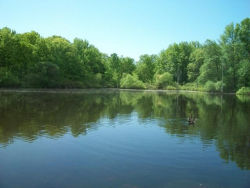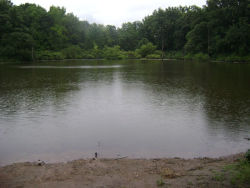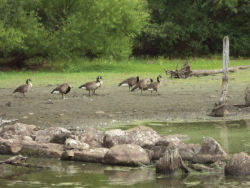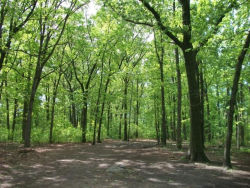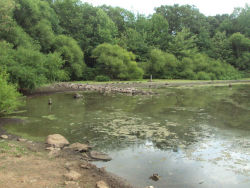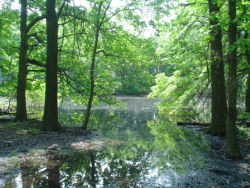King Fisher Park
Kingfisher Park
The belted kingfisher (Ceryle alcyon), a marine bird-of-prey known for its loud, dry, rattle, is a year-round resident of the New York City area. It has a pointed powerful bill, and a large, ragged crest fore and rear. This crest and its diet of fish earned the kingfisher its majestic name. The bird frequently sits on tree limbs that jut out over the water until it spots its prey, usually small fish. When the moment is right, the kingfisher will dive into the water and fish out its meal.
Kingfisher Park is bounded by Fairfield Street and Miles, Corbin, and Barlow Avenues. The Fairfield Street entrance gate displays an image of a kingfisher’s head. Blue, red, and yellow trail markers help visitors navigate the major walking trails. The red trail offers views of an old rock wall that was built by Dutch farmers in the 18th century. Today, the wall winds its way through the park, disappearing at last under the surface of the pond. The blue trail follows the bank of the pond, affording hikers a clear view of water fowl, while the yellow trail cuts straight through the park from north to south.
The park is a wildlife oasis, home to a large variety of ecosystems. A successional meadow, once a farmer’s field or a shallow pond, has been slowly changing over the last two centuries into a climax forest, which contains oak (quercus), hickory (carya), and beech trees (fagus grandiolia), as well as an under-story of Red maple (acer rubrum), dogwood (cornus sericea), and black cherry trees (prunus serotina). A climax forest is one that has reached the final stage in its evolution. The individual trees may grow, change, or die, but the species of the forest remain the same. A forest that is still in succession may undergo more material changes as one species crowds out or overshadows another.
The freshwater pond and surrounding wetlands also host a variety of wildlife. In 1999, during a two-hour bird watch, wildlife enthusiasts counted thirty-five distinct species of birds. In addition to the kingfishers, the park is also home to glossy ibises (mycteria americana), spring peepers, great egrets (casmerodius albus), and snowy egrets (egretta thula). The pond contains frogs, turtles, catfish, sonnies and carp. The trees and undergrowth provide a backdrop for wildflowers such as the pink swamp mallow (hibiscus moscheutos) along the water’s edge, and the unusual pink lady’s slipper (cypripedium reginae), a large, cucumber-root plant.
The New York City Department of Environmental Protection Bluebelt Project protects wetland areas so that they can perform their natural functions of receiving, filtering, moving, and storing storm water. Because healthy wetlands decrease the need for drainage basins and sewers, the program saves millions of dollars in infrastructure costs. This parkland, which provides natural flood protection for its surrounding area, is a crucial part of the Bluebelt Project on Staten Island.
Local preservation groups such as the Protectors of Pine Oak Woods lobbied to preserve this natural area. In 1997 Mayor Rudolph Giuliani, Borough President Guy V. Molinari, Council Member Stephen J. Fiala, and a State Environmental Quality Bond Act grant provided $1 million to acquire the park. Previously known as Islington Pond for the pond that anchors the park, Commissioner Stern renamed it Kingfisher Park. In 1998 and 1999, local groups like the Eagle Scouts and the Park Conservation Corps completed renovations of trails and lands damaged by prohibited ATV (All Terrain Vehicle) use.
Check out your park's Vital Signs
Clean & Safe
Green & Resilient
Empowered & Engaged Users
Share your feedback or learn more about how this park is part of a
Vital Park System

